The SRS’ Growth in 2015
The Singapore Registry of Ships maintained its growth momentum last year. Compared to 2014, the total tonnage of ships under MPA’s register grew by 4.9 per cent or 4.1 million GT. In 2015, the total tonnage of ships under the Singapore flag climbed to 86.3 million GT, from 82.2 million GT in 2014, consolidating Singapore’s position as one of the top five ship registries in the world.

The Singapore Flag’s Performance in 2015
For the year of 2015, the Singapore Flag performed well under Port State Control (PSC). During the PSC Concentrated Inspection Campaign (CIC) on Crew Familiarisation for Enclosed Space Entry from September to November 2015, most Singapore ships were found compliant and had effective procedures and measures in place to safeguard seafarers entering and working in enclosed spaces.
Similar to 2014, the majority of the PSC detentions took place in Australia and the United States due to common detainable deficiencies. These are systemic problems which have to be addressed effectively with the cooperation of our shipowners, companies, ship’s crews and Recognised Organisations (ROs).
Tokyo MoU PSC Regime
The annual detention ratio of Singapore ships in 2015 was 1.02% against the regime’s average of 3.70%, a slight improvement in performance from the previous year. The majority of Singapore ship detentions (19 in total) took place in Australia.
There is also an improvement in the three-year rolling average detention ratio of Singapore ships in 2015 (0.94% against the regime’s average of 4.06%). This statistic serves as a performance indicator to determine the position of flags in the PSC Black-Grey-White List.
The Singapore Flag is ranked 4th out of 30 White List Flags under the Tokyo MoU PSC Regime in 2015.
Tokyo MoU Detention Ratio
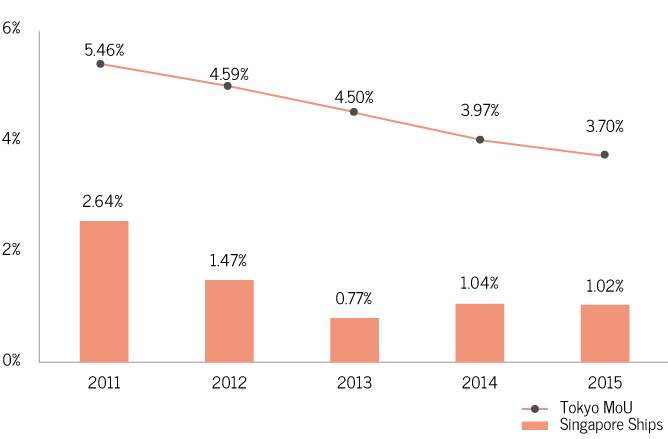
Tokyo MoU 3-Year Rolling Average Detention Ratio
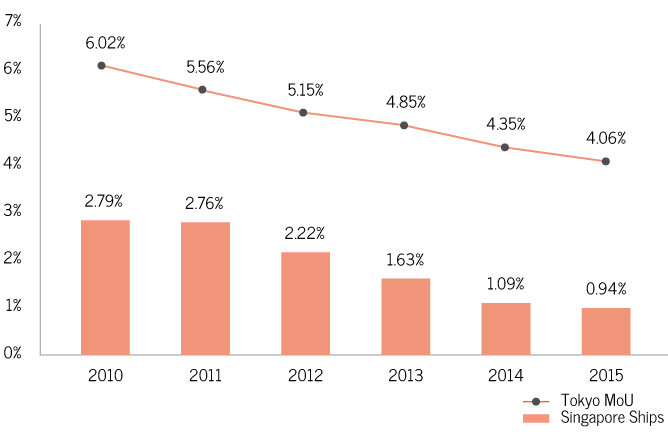
Paris MoU PSC Regime
The annual detention ratio of Singapore ships in 2015 was 1.79% against the regime’s average of 3.28%, a significant fall in performance from the previous two years, due to detentions in Belgium, Spain, Italy and the Netherlands.
Nevertheless, there is an improvement in the three-year rolling average detention ratio of Singapore ships in 2015 (1.42% against the regime’s average of 3.44%).
The Singapore Flag is ranked 11th out of 43 White List Flags under the Paris MoU PSC Regime in 2015.
Paris MoU Detention Ratio
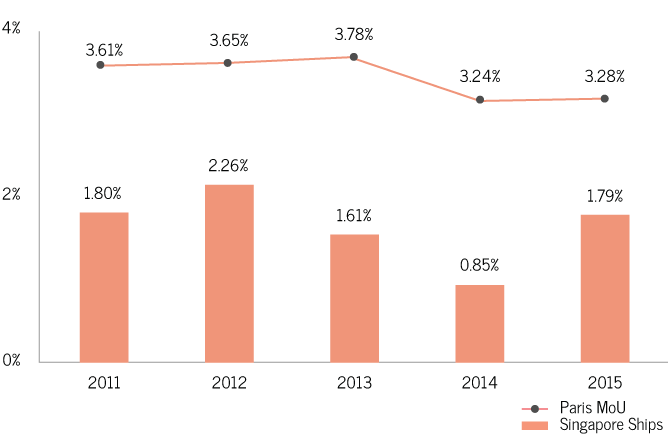
Paris MoU 3-Year Rolling Average Detention Ratio
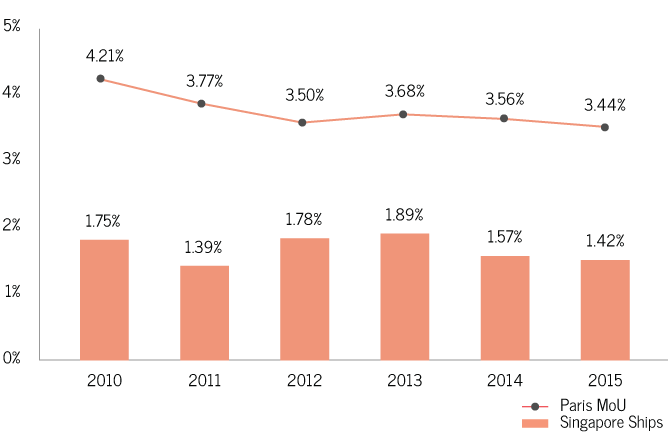
United States Coast Guard PSC
A total of 9 Singapore ships were detained in the United States in 2015, a slight increase from 8 detentions in 2014 and 5 detentions in 2013.
The statistics for 2015 are not available yet.
MPA – Flag State Control
The annual detention ratio of Singapore ships in 2015 was 0.84%, the lowest in the past five years. This reflects a general improvement in the safety standards of Singapore ships.
FSC Detention Ratio
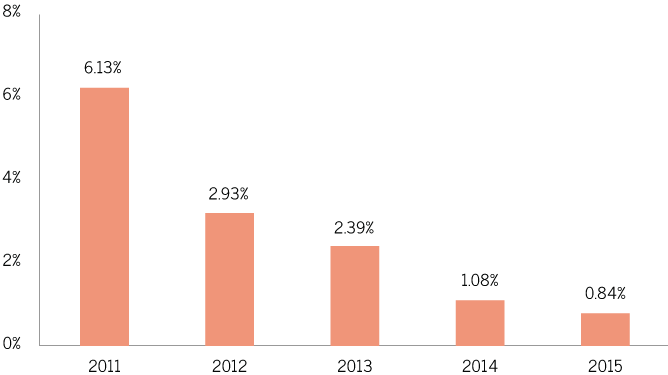
Ship Detentions by Ship Type
In 2015, bulk carriers and container ships account for more than 60% of Singapore ship detentions.
For the first time ever, a Singapore jack-up rig (MODU) was detained. It took place in Dampier, Australia.
PSC Detention of Singapore Ships by Ship Type
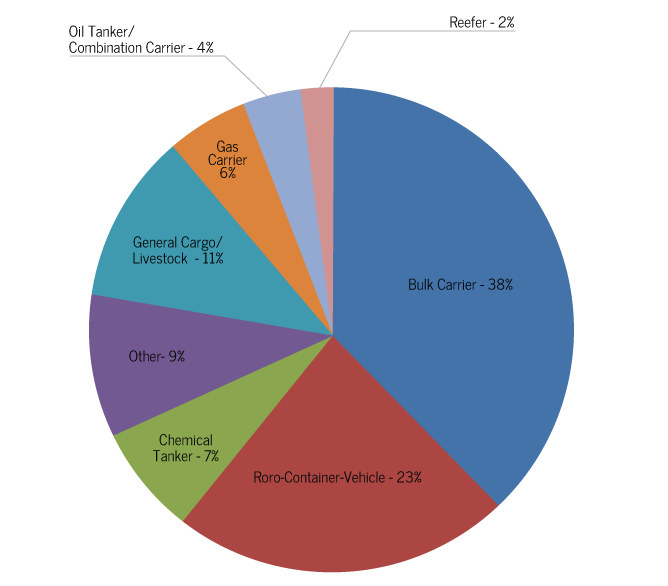
Ship Detentions by Port States
In 2015, 53% of Singapore Ship detentions took place in Australia and the United States. The detentions were due to common detainable deficiencies, which will be highlighted in the next section.
PSC Detention of Singapore Ships by Port State
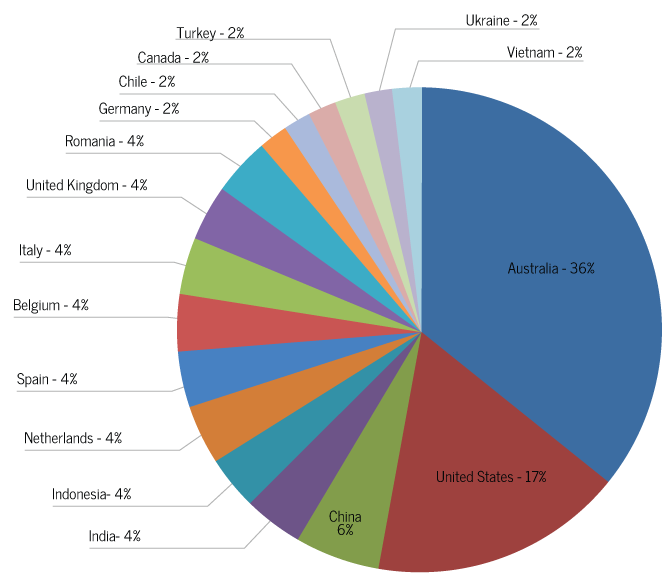
Most Common Causes of Ship Detentions
From the analysis of Singapore ship detentions over the past three years, the four most common categories of PSC detention deficiencies are Fire Safety, ISM-related, Pollution Prevention, and Life-Saving Appliances. This is a recurring theme, which requires the attention of our shipowners, companies, crew and ROs. Under these four categories, the recurring PSC detention deficiencies are summarised as follows:
- Fire Safety
- Fire-dampers seized in open position or unable to be closed fully
- Pilot lines for CO2 bottles of fixed fire fighting system disconnected or kinked
- Fixed water-based local application fire fighting system in engine room set on manual/local mode of operation and not operationally ready
- Defective self-closing device for fire doors
- Defective fire detection and alarm system
- ISM-related
- Inappropriate voyage planning and use of inadequate or outdated nautical charts
- Inadequate management and recording of seafarers’ hours of rest
- Poor maintenance of safety and critical shipboard equipment
- Pollution Prevention
- Defective sewage treatment plant
- Defective oily water separator and 15ppm alarm arrangements
- Life-Saving Appliances
- Lifeboat and rescue boat engine not able to be launched
- Defective lifeboat and rescue boat launching arrangement
Detention Deficiencies by Category
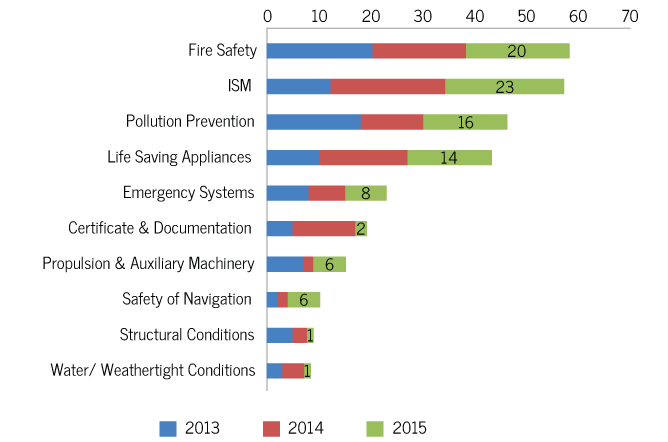
Top 10 Detention Deficiencies
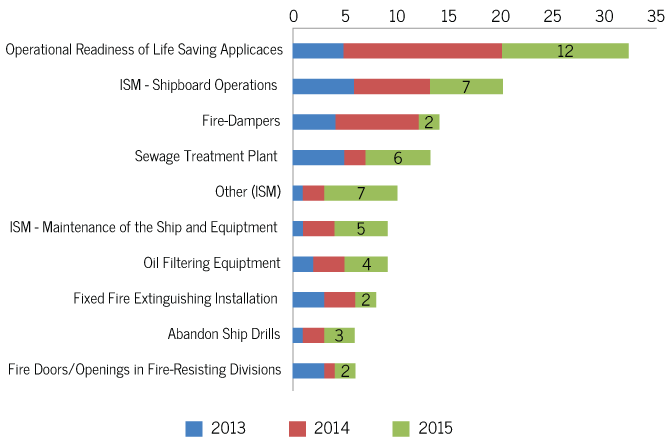
In 2015, we also saw a spike in the number of Singapore ships being detained due to defective sewage treatment plants (6 detentions in 2015 against 2 detentions in 2014). This was commonly caused by the aeration blower not working correctly, rendering the sewage treatment plant ineffective. In such cases, if the overboard discharge valve was kept open, the PSC officer might conclude that untreated sewage was being discharged into their waters, and this would be taken seriously. We will dwell deeper into this topic in the next section.
To conclude the year, and as part of MPA’s continual effort to work with key stakeholders to maintain a quality flag, MPA organised two dialogue sessions in November 2015. The objective of the dialogue session was to share important statistics including trend analysis of ship detentions relevant to Singapore ships, and to discuss ways to tackle recurring detainable deficiencies by leveraging on companies’ safety management system.
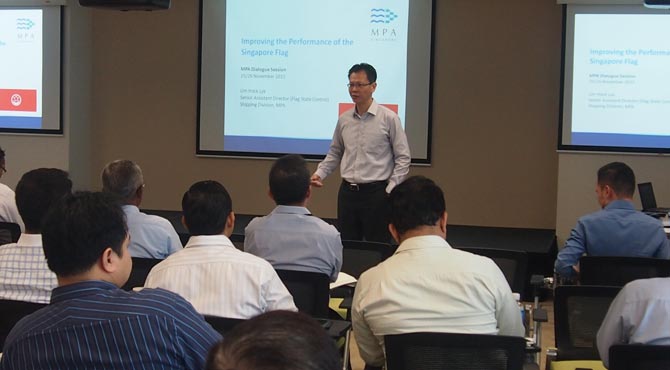
Senior Assistant Director (Flag State Control), Mr Lim Hock Lye, sharing on ways to improve the performance of the Singapore Flag
Case Study - Prevention of Pollution by Sewage From Ships
Sewage Treatment Plants on Ships
Under the revised Annex IV of the MARPOL Convention, seagoing ships of 400 gross tonnage and above, or ships which are certified to carry more than 15 persons, have to be fitted with an approved sewage treatment plant, or sewage comminuting and disinfecting system, or sewage holding tank to control the discharge of sewage into the sea.
The condition of a ship and its pollution prevention equipment have to be properly maintained at all times to ensure the ship can proceed to sea without presenting an unreasonable threat or harm to the marine environment. After any survey, no change to the ship’s structure, equipment or systems is allowed without the authorisation of the flag Administration. In addition, whenever a serious defect is discovered on the ship, equipment or systems, the master or owner of the ship must report at the earliest opportunity to the flag Administration or recognised organization, as well as to the appropriate authority of the port State if the ship is in a foreign port.
Biological sewage treatment plant
Ships are commonly fitted with biological sewage treatment plants, which typically comprises of three stages - the aeration chamber, separation tank and treatment tank. In the aeration chamber, incoming sewage is decomposed into carbon dioxide by the aerobic bacteria which survive on oxygen supplied by an aeration blower. In the separation tank, sludge is separated from liquid and is recycled back to the aeration chamber for further treatment. The liquid in the separation tank overflows into the treatment tank where it is disinfected by chlorination and/or a UV steriliser. The treated effluent is automatically discharged overboard by means of level control. When the sewage treatment plant is effective, the effluent is normally clear and light brown in colour, and with little odour.
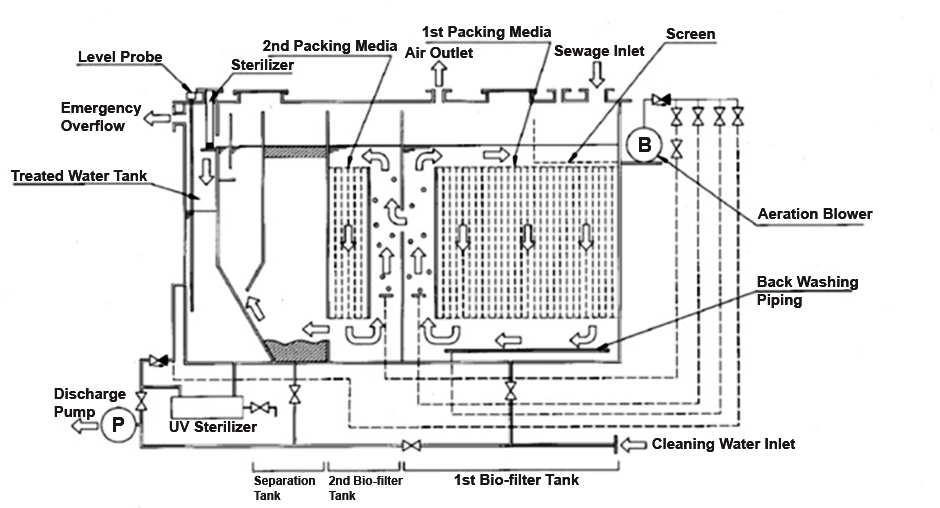
Working diagram of a typical biological sewage treatment plant
To ensure the sewage treatment plant works properly, the control of air supply (0.15 - 0.3 bar) to the aeration chamber and separation tank in accordance with the maker’s recommendations is very important. Insufficient air supply/oxygen can lead to improper decomposition of sewage, or growth of anaerobic bacteria which produces highly toxic and foul gases, and discoloration of the effluent.
Regular back flushing and removal of insoluble sludge in the aeration chamber and separation tank is also necessary to prevent clogging of the system and carryover of sludge into the treatment tank.
Common deficiencies related to sewage treatment plant
In recent years, we have seen more ships being detained because of improper operation and maintenance of sewage treatment systems. Common deficiencies included:
- Untreated sewage being discharged overboard in port because the sewage treatment plant was bypassed or the overboard discharge valve was seized or kept in “open to sea” position.
- Aeration blowers were defective or not switched on when sewage treatment plant is in use
- Unauthorised modification to supply air to the sewage treatment plant instead of repairing the defective aeration blower.
- Level alarms or automatic operation of the discharge pump was defective.
- Improper operation and maintenance of sewage treatment plant, e.g. suction filter of aeration blower dirty/clogged, sludge return line (air lift) choked.
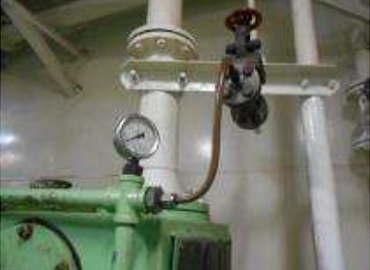
Unauthorised modification to supply air to the sewage treatment plant
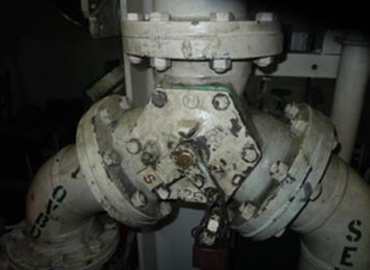
3-way change over valve in “open to sea” position. Valve handle had slipped on spindle
Case Study
To better understand the underlying causes of deficiencies relating to sewage treatment plant, we will now share a case study of a recent ship detention.
The ship’s engineers had overhauled the aeration blower of the sewage treatment plant under their planned maintenance. Two weeks later during a PSC inspection, the sewage treatment plant was subject to a detailed inspection. The cover of the aeration chamber was opened and the PSCO observed that there was insufficient air bubbling up and significant amount of sludge floating in the chamber. The discharge pressure of the aeration blower was checked and found very weak. The pressure gauge was defective and its needle stuck in the normal pressure range. The PSCO asked for a sample of the effluent to be drawn and saw that it was dark brown in colour. The PSCO concluded that the aeration blower was defective and untreated sewage was being discharged into their waters. The ship was duly detained. The aeration blower was landed ashore for repair and the shaft found bent, possibly due to incorrect assembly after it was last overhauled on board.
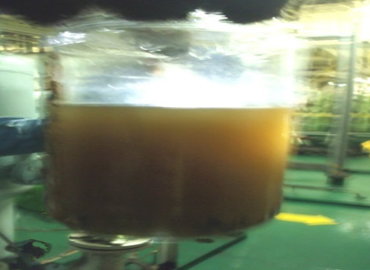
Sample of effluent collected
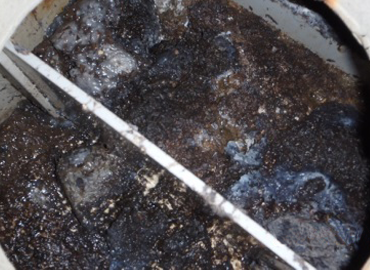
Internal condition of aeration chamber
Underlying Causes of Deficiencies
- The crew were not familiar with the operation and maintenance of the sewage treatment plant.
- Repair and maintenance of the sewage treatment plant was not carried out in accordance with the maker’s recommendation.
- Operational test of the air blower and sewage treatment plant was not properly carried out and verified after repair work on the system.
- There was lack of supervision and oversight by senior ship’s officers.
- Inspection of the sewage treatment plant during engine room watchkeeping was not effective.
Simple and Actionable Corrective Actions
Getting the job done right the first time and every time!

- Provide clear and adequate procedure and work instructions in the safety management system to enable the crew to carry out inspection, testing and maintenance of the sewage treatment plant (or other critical equipment or system) effectively and consistently, taking into account of mandatory requirements and maker’s recommendations.
- Ensure the crew are properly familiarised in the operation and maintenance of the sewage treatment plant, as well as relevant mandatory requirements.
- Ensure watchkeeping personnel are proficient in checking the proper setting and operation of the sewage treatment plant and system. Watchkeeping checklist should identify critical parameters, such as the required air pressure of the sewage treatment plant to be maintained.
- Ensure senior ship’s officers properly supervise and oversee the work being carried out on board.
References:
- MARPOL Annex IV, regulation 4 (Surveys) and regulation 9 (Sewage systems)
- Resolution MEPC.159(55), 2012 Guidelines on Implementation of Effluent Standards and Performance Tests for Sewage Treatment Plants
- Resolution MEPC.227(64), Revised Guidelines on Implementation of Effluent Standards and Performance Tests for Sewage Treatment Plants
- ISM Code, section 6 (Resources and personnel) and section 10 (Maintenance of the ship and equipment)
